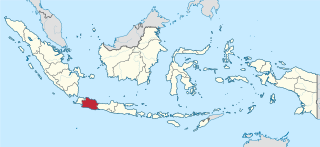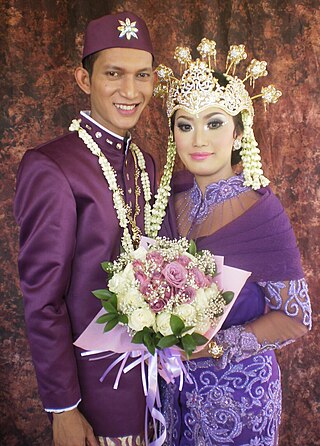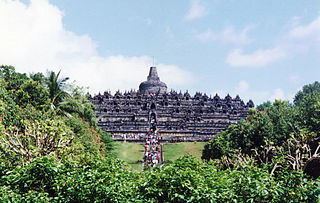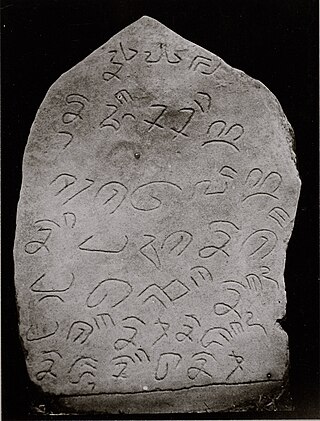
West Java is a province of Indonesia on the western part of the island of Java, with its provincial capital in Bandung. West Java is bordered by the province of Banten and the country's capital region of Jakarta to the west, the Java Sea to the north, the province of Central Java to the east and the Indian Ocean to the south. With Banten, this province is the native homeland of the Sundanese people, the second-largest ethnic group in Indonesia.

The Sunda or Sundanese are an indigenous ethnic group native to the western region of Java island in Indonesia, primarily West Java. They number approximately 42 million and form Indonesia's second most populous ethnic group. They speak the Sundanese language, which is part of the Austronesian languages.

Ciamis is a district and a town; it is the location of the regency seat of Ciamis Regency in West Java, Indonesia. It covers an area of 33.85 km2 and had a population of 93,744 at the 2010 Census and 98,610 at the 2020 Census; the official estimate as of mid-2022 was 99,750.

Kuningan Regency is a regency (kabupaten) of West Java province of Indonesia. It covers an area of 1,194.09 km2, and it had a population of 1,035,589 at the 2010 census and 1,167,686 at the 2020 census; the official estimate as at mid 2022 was 1,196,017. Kuningan Regency is located in the east of the province, south of Cirebon Regency and bordering Central Java Province to the east and southeast. The town and district of Kuningan is its administrative capital.

Kingdoms of Sunda refers to the monarchies of the Sundanese region prior to the establishment of Indonesia in 1945 AD. The history includes several eras:
- Salakanagara
- Tarumanagara
- The Sunda Kingdom and Galuh Kingdom
- Kingdom of Sumedang Larang, The Sultanate of Banten & The Sultanate of Cirebon

Tarumanagara or Taruma Kingdom or just Taruma was an early Sundanese Indianised kingdom, located in western Java, whose 5th-century ruler, Purnawarman, produced the earliest known inscriptions in Java, which are estimated to date from around 450 CE.

The Sunda Kingdom was a Sundanese Hindu kingdom located in the western portion of the island of Java from 669 to around 1579, covering the area of present-day Banten, Jakarta, West Java, and the western part of Central Java. The capital of the Sunda Kingdom moved several times during its history, shifting between the Galuh (Kawali) area in the east and Pakuan Pajajaran in the west.

The Sultanate of Cirebon was an Islamic sultanate in West Java founded in the 15th century. It is said to have been founded by Sunan Gunungjati, as marked by his letter proclaiming Cirebon's independence from Pajajaran in 1482, although the settlement and the polity had been established earlier, in 1445. Sunan Gunungjati also established the Sultanate of Banten. It was one of the earliest Islamic states established in Java, along with the Sultanate of Demak.

Pakuan Pajajaran was the fortified capital city of Sunda Kingdom. The location roughly corresponds to modern Bogor city in West Java, Indonesia, approximately around the site of Batu Tulis. The site is revered as the spiritual home of Sundanese people as it contains much of the shared identity and history of Sundanese people.
Sri Baduga Maharaja or Sang Ratu Jayadewata was the great king of the Hindu Sunda kingdom in West Java, reigned 1482 to 1521 from his capital in Pakuan Pajajaran. He brought his kingdom greatness and prosperity.

Parahyangan or Priangan is a cultural and mountainous region in West Java province on the Indonesian island of Java. Covering a little less than one-sixth of Java, it is the heartland of Sundanese people and their culture. It is bordered to the West by Banten province, to the North by the northern coast region of Subang, Cirebon, and Indramayu, to the east by Central Java province, and to the south by the Indian Ocean.

Sunda Wiwitan is a folk religion and ancient beliefs adhered to by the Sundanese in Indonesia.
The Battle of Bubat also known as Pasunda Bubat is the battle between the Sundanese royal family and the Majapahit army that took place in Bubat Square on the northern part of Trowulan in 1279 Saka or 1357 CE.

Old Sundanese script is a script that developed in West Java in the 14th–18th centuries which was originally used to write Old Sundanese language. The Old Sundanese script is a development of the Pallava script which has reached the stage of modifying its distinctive form as used in lontar texts in the 16th century.

Sumedang Larang is an Islamic Kingdom based in Sumedang, West Java. Its territory consisted of the Parahyangan region, before becoming a vassal state under the Mataram Sultanate.

King Siliwangi or Prabu Siliwangi was a semi-legendary great king of the Hindu Sunda kingdom before the coming of Islam in West Java.
King Niskala Wastu Kancana also known as Prabu Raja Wastu or popularly known as Wastu Kancana was one of the great kings of the Sunda Kingdom reigning throughout most of the 15th century. He was the younger brother of Princess Pitaloka.

Kawali was the capital of Sunda Kingdom during Galuh period, between early 14th to late 15th century. It is located in present day Astana Gede archaeological site, Kawali subdistrict, Ciamis Regency, West Java, Indonesia.

The history of Sunda Kingdom spanned almost a millennium, between 7th to 16th century. It is not sure however, whether the Sunda Kingdom was actually a continuous polity or not, nor whether its rulers belongs to a single continuous lineage of dynasty or not. This is because the scarcity of evidences, historical records and archaeological findings that plausibly connected to this kingdom.

Old Sundanese is the earliest recorded stage of the Sundanese language which is spoken in the western part of Java, Indonesia. The evidence is recorded in inscriptions from around the 12th to 14th centuries and ancient palm-leaf manuscripts from the 15th to 17th centuries AD. Old Sundanese is no longer used today, but has developed into its descendant, modern Sundanese.



















